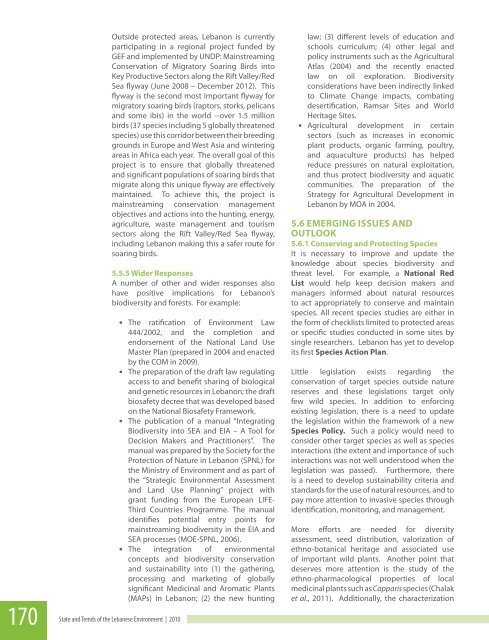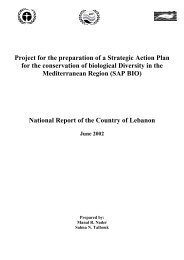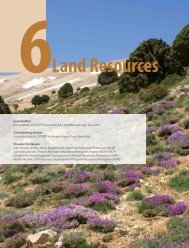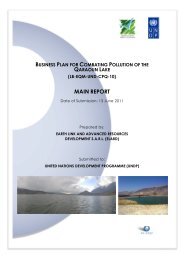Biodiversity and Forests
Biodiversity and Forests
Biodiversity and Forests
You also want an ePaper? Increase the reach of your titles
YUMPU automatically turns print PDFs into web optimized ePapers that Google loves.
170<br />
Outside protected areas, Lebanon is currently<br />
participating in a regional project funded by<br />
GEF <strong>and</strong> implemented by UNDP: Mainstreaming<br />
Conservation of Migratory Soaring Birds into<br />
Key Productive Sectors along the Rift Valley/Red<br />
Sea flyway (June 2008 – December 2012). This<br />
flyway is the second most important flyway for<br />
migratory soaring birds (raptors, storks, pelicans<br />
<strong>and</strong> some ibis) in the world --over 1.5 million<br />
birds (37 species including 5 globally threatened<br />
species) use this corridor between their breeding<br />
grounds in Europe <strong>and</strong> West Asia <strong>and</strong> wintering<br />
areas in Africa each year. The overall goal of this<br />
project is to ensure that globally threatened<br />
<strong>and</strong> significant populations of soaring birds that<br />
migrate along this unique flyway are effectively<br />
maintained. To achieve this, the project is<br />
mainstreaming conservation management<br />
objectives <strong>and</strong> actions into the hunting, energy,<br />
agriculture, waste management <strong>and</strong> tourism<br />
sectors along the Rift Valley/Red Sea flyway,<br />
including Lebanon making this a safer route for<br />
soaring birds.<br />
5.5.5 Wider Responses<br />
A number of other <strong>and</strong> wider responses also<br />
have positive implications for Lebanon’s<br />
biodiversity <strong>and</strong> forests. For example:<br />
• The ratification of Environment Law<br />
444/2002, <strong>and</strong> the completion <strong>and</strong><br />
endorsement of the National L<strong>and</strong> Use<br />
Master Plan (prepared in 2004 <strong>and</strong> enacted<br />
by the COM in 2009).<br />
• The preparation of the draft law regulating<br />
access to <strong>and</strong> benefit sharing of biological<br />
<strong>and</strong> genetic resources in Lebanon; the draft<br />
biosafety decree that was developed based<br />
on the National Biosafety Framework.<br />
• The publication of a manual “Integrating<br />
<strong>Biodiversity</strong> into SEA <strong>and</strong> EIA – A Tool for<br />
Decision Makers <strong>and</strong> Practitioners”. The<br />
manual was prepared by the Society for the<br />
Protection of Nature in Lebanon (SPNL) for<br />
the Ministry of Environment <strong>and</strong> as part of<br />
the “Strategic Environmental Assessment<br />
<strong>and</strong> L<strong>and</strong> Use Planning” project with<br />
grant funding from the European LIFE-<br />
Third Countries Programme. The manual<br />
identifies potential entry points for<br />
mainstreaming biodiversity in the EIA <strong>and</strong><br />
SEA processes (MOE-SPNL, 2006).<br />
• The integration of environmental<br />
concepts <strong>and</strong> biodiversity conservation<br />
<strong>and</strong> sustainability into (1) the gathering,<br />
processing <strong>and</strong> marketing of globally<br />
significant Medicinal <strong>and</strong> Aromatic Plants<br />
(MAPs) in Lebanon; (2) the new hunting<br />
State <strong>and</strong> Trends of the Lebanese Environment | 2010<br />
law; (3) different levels of education <strong>and</strong><br />
schools curriculum; (4) other legal <strong>and</strong><br />
policy instruments such as the Agricultural<br />
Atlas (2004) <strong>and</strong> the recently enacted<br />
law on oil exploration. <strong>Biodiversity</strong><br />
considerations have been indirectly linked<br />
to Climate Change impacts, combating<br />
desertification, Ramsar Sites <strong>and</strong> World<br />
Heritage Sites.<br />
• Agricultural development in certain<br />
sectors (such as increases in economic<br />
plant products, organic farming, poultry,<br />
<strong>and</strong> aquaculture products) has helped<br />
reduce pressures on natural exploitation,<br />
<strong>and</strong> thus protect biodiversity <strong>and</strong> aquatic<br />
communities. The preparation of the<br />
Strategy for Agricultural Development in<br />
Lebanon by MOA in 2004.<br />
5.6 EMERGING ISSUES AND<br />
OUTLOOK<br />
5.6.1 Conserving <strong>and</strong> Protecting Species<br />
It is necessary to improve <strong>and</strong> update the<br />
knowledge about species biodiversity <strong>and</strong><br />
threat level. For example, a National Red<br />
List would help keep decision makers <strong>and</strong><br />
managers informed about natural resources<br />
to act appropriately to conserve <strong>and</strong> maintain<br />
species. All recent species studies are either in<br />
the form of checklists limited to protected areas<br />
or specific studies conducted in some sites by<br />
single researchers. Lebanon has yet to develop<br />
its first Species Action Plan.<br />
Little legislation exists regarding the<br />
conservation of target species outside nature<br />
reserves <strong>and</strong> these legislations target only<br />
few wild species. In addition to enforcing<br />
existing legislation, there is a need to update<br />
the legislation within the framework of a new<br />
Species Policy. Such a policy would need to<br />
consider other target species as well as species<br />
interactions (the extent <strong>and</strong> importance of such<br />
interactions was not well understood when the<br />
legislation was passed). Furthermore, there<br />
is a need to develop sustainability criteria <strong>and</strong><br />
st<strong>and</strong>ards for the use of natural resources, <strong>and</strong> to<br />
pay more attention to invasive species through<br />
identification, monitoring, <strong>and</strong> management.<br />
More efforts are needed for diversity<br />
assessment, seed distribution, valorization of<br />
ethno-botanical heritage <strong>and</strong> associated use<br />
of important wild plants. Another point that<br />
deserves more attention is the study of the<br />
ethno-pharmacological properties of local<br />
medicinal plants such as Capparis species (Chalak<br />
et al., 2011). Additionally, the characterization





